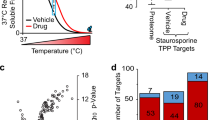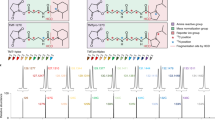Abstract
Mass spectrometry assays demonstrate that Hsp90 inhibitors alter the expression of approximately one-quarter of the assayable proteome in mammalian cells. These changes are extraordinarily robust and reproducible, making “proteomics profiling” the gold standard for validating the effects of new Hsp90 inhibitors on cultured cells. Proteomics assays can also suggest novel hypotheses regarding drug mechanisms. To assist investigators in adopting this approach, this Chapter provides detailed protocols for conducting simple proteomics assays of Hsp90 inhibition. The protocols present a robust label-free approach that utilizes pre-fractionation of protein samples by SDS-PAGE, thereby providing reasonably good penetration into the proteome while addressing common issues with sample quality. The actual programming and operation of liquid chromatography-tandem mass spectrometers is not covered, but expectations for achievable performance are discussed, as are alternative approaches, common challenges, and software for data analysis.
Access this chapter
Tax calculation will be finalised at checkout
Purchases are for personal use only
Similar content being viewed by others
References
Che Y, Best OG, Zhong L, Kaufman KL, Mactier S, Raftery M, Graves LM, Mulligan SP, Christopherson RI (2013) Hsp90 inhibitor SNX-7081 dysregulates proteins involved with DNA repair and replication and the cell cycle in human chronic lymphocytic leukemia (CLL) cells. J Proteome Res 12(4):1710–1722. https://doi.org/10.1021/pr301055y
Fierro-Monti I, Echeverria P, Racle J, Hernandez C, Picard D, Quadroni M (2013) Dynamic impacts of the inhibition of the molecular chaperone Hsp90 on the T-cell proteome have implications for anti-cancer therapy. PLoS One 8(11):e80425. https://doi.org/10.1371/journal.pone.0080425
Jacobson C, Kopp N, Layer JV, Redd RA, Tschuri S, Haebe S, van Bodegom D, Bird L, Christie AL, Christodoulou A, Saur A, Tivey T, Zapf S, Bararia D, Zimber-Strobl U, Rodig SJ, Weigert O, Weinstock DM (2016) HSP90 inhibition overcomes ibrutinib resistance in mantle cell lymphoma. Blood. https://doi.org/10.1182/blood-2016-04-711176
Samant RS, Clarke PA, Workman P (2012) The expanding proteome of the molecular chaperone HSP90. Cell Cycle 11(7):1301–1308. https://doi.org/10.4161/cc.19722
Sharma K, Vabulas RM, Macek B, Pinkert S, Cox J, Mann M, Hartl FU (2012) Quantitative proteomics reveals that Hsp90 inhibition preferentially targets kinases and the DNA damage response. Mol Cell Proteomics 11(3):M111.014654. https://doi.org/10.1074/mcp.M111.014654
Voruganti S, Lacroix JC, Rogers CN, Rogers J, Matts RL, Hartson SD (2013) The anticancer drug AUY922 generates a proteomics fingerprint that is highly conserved among structurally diverse Hsp90 inhibitors. J Proteome Res 12(8):3697–3706. https://doi.org/10.1021/pr400321x
Wu Z, Gholami AM, Kuster B (2012) Systematic identification of the HSP90 candidate regulated proteome. Mol Cell Proteomics 11(6):M111.016675. https://doi.org/10.1074/mcp.M111.016675
Hartson SD, Matts RL (2012) Approaches for defining the Hsp90-dependent proteome. Biochim Biophys Acta 1823(3):656–667. https://doi.org/10.1016/j.bbamcr.2011.08.013
Whitesell L, Mimnaugh EG, De Costa B, Myers CE, Neckers LM (1994) Inhibition of heat shock protein HSP90-pp60v-src heteroprotein complex formation by benzoquinone ansamycins: essential role for stress proteins in oncogenic transformation. Proc Natl Acad Sci U S A 91(18):8324–8328
Schulte TW, Blagosklonny MV, Ingui C, Neckers L (1995) Disruption of the Raf-1-Hsp90 molecular complex results in destabilization of Raf-1 and loss of Raf-1-Ras association. J Biol Chem 270(41):24585–24588
Smith DF, Whitesell L, Nair SC, Chen S, Prapapanich V, Rimerman RA (1995) Progesterone receptor structure and function altered by geldanamycin, an hsp90-binding agent. Mol Cell Biol 15(12):6804–6812
Hartson SD, Barrett DJ, Burn P, Matts RL (1996) Hsp90-mediated folding of the lymphoid cell kinase p56lck. Biochemistry 35(41):13451–13459. https://doi.org/10.1021/bi961332c
Schulte TW, Blagosklonny MV, Romanova L, Mushinski JF, Monia BP, Johnston JF, Nguyen P, Trepel J, Neckers LM (1996) Destabilization of Raf-1 by geldanamycin leads to disruption of the Raf-1-MEK-mitogen-activated protein kinase signalling pathway. Mol Cell Biol 16(10):5839–5845
Aebersold R, Mann M (2016) Mass-spectrometric exploration of proteome structure and function. Nature 537(7620):347–355. https://doi.org/10.1038/nature19949
Blagoev B, Ong SE, Kratchmarova I, Mann M (2004) Temporal analysis of phosphotyrosine-dependent signaling networks by quantitative proteomics. Nat Biotechnol 22(9):1139–1145. https://doi.org/10.1038/nbt1005
Hubner NC, Ren S, Mann M (2008) Peptide separation with immobilized pI strips is an attractive alternative to in-gel protein digestion for proteome analysis. Proteomics 8(23–24):4862–4872. https://doi.org/10.1002/pmic.200800351
Richards AL, Merrill AE, Coon JJ (2015) Proteome sequencing goes deep. Curr Opin Chem Biol 24:11–17. https://doi.org/10.1016/j.cbpa.2014.10.017
Ong SE, Blagoev B, Kratchmarova I, Kristensen DB, Steen H, Pandey A, Mann M (2002) Stable isotope labeling by amino acids in cell culture, SILAC, as a simple and accurate approach to expression proteomics. Mol Cell Proteomics 1(5):376–386
Batth TS, Olsen JV (2016) Offline high pH reversed-phase peptide fractionation for deep phosphoproteome coverage. Methods Mol Biol 1355:179–192. https://doi.org/10.1007/978-1-4939-3049-4_12
Lau KW, Jones AR, Swainston N, Siepen JA, Hubbard SJ (2007) Capture and analysis of quantitative proteomic data. Proteomics 7(16):2787–2799. https://doi.org/10.1002/pmic.200700127
Remily-Wood ER, Liu RZ, Xiang Y, Chen Y, Thomas CE, Rajyaguru N, Kaufman LM, Ochoa JE, Hazlehurst L, Pinilla-Ibarz J, Lancet J, Zhang G, Haura E, Shibata D, Yeatman T, Smalley KS, Dalton WS, Huang E, Scott E, Bloom GC, Eschrich SA, Koomen JM (2011) A database of reaction monitoring mass spectrometry assays for elucidating therapeutic response in cancer. Proteomics Clin Appl 5(7–8):383–396. https://doi.org/10.1002/prca.201000115
Hartson SD, Matts RL (1994) Association of Hsp90 with cellular Src-family kinases in a cell-free system correlates with altered kinase structure and function. Biochemistry 33(30):8912–8920
Cox J, Hein MY, Luber CA, Paron I, Nagaraj N, Mann M (2014) Accurate proteome-wide label-free quantification by delayed normalization and maximal peptide ratio extraction, termed MaxLFQ. Mol Cell Proteomics 13(9):2513–2526. https://doi.org/10.1074/mcp.M113.031591
Cox J, Mann M (2008) MaxQuant enables high peptide identification rates, individualized p.p.b.-range mass accuracies and proteome-wide protein quantification. Nat Biotechnol 26(12):1367–1372. https://doi.org/10.1038/nbt.1511
Beck S, Michalski A, Raether O, Lubeck M, Kaspar S, Goedecke N, Baessmann C, Hornburg D, Meier F, Paron I, Kulak NA, Cox J, Mann M (2015) The impact II, a very high-resolution quadrupole time-of-flight instrument (QTOF) for deep shotgun proteomics. Mol Cell Proteomics 14(7):2014–2029. https://doi.org/10.1074/mcp.M114.047407
Tyanova S, Temu T, Sinitcyn P, Carlson A, Hein MY, Geiger T, Mann M, Cox J (2016) The Perseus computational platform for comprehensive analysis of (prote)omics data. Nat Methods 13(9):731–740. https://doi.org/10.1038/nmeth.3901
Diz AP, Carvajal-Rodriguez A, Skibinski DO (2011) Multiple hypothesis testing in proteomics: a strategy for experimental work. Mol Cell Proteomics 10(3):M110.004374. https://doi.org/10.1074/mcp.M110.004374
Coscia F, Watters KM, Curtis M, Eckert MA, Chiang CY, Tyanova S, Montag A, Lastra RR, Lengyel E, Mann M (2016) Integrative proteomic profiling of ovarian cancer cell lines reveals precursor cell associated proteins and functional status. Nat Commun 7:12645. https://doi.org/10.1038/ncomms12645
Cristobal A, Hennrich ML, Giansanti P, Goerdayal SS, Heck AJ, Mohammed S (2012) In-house construction of a UHPLC system enabling the identification of over 4000 protein groups in a single analysis. Analyst 137(15):3541–3548. https://doi.org/10.1039/c2an35445d
Hebert AS, Richards AL, Bailey DJ, Ulbrich A, Coughlin EE, Westphall MS, Coon JJ (2014) The one hour yeast proteome. Mol Cell Proteomics 13(1):339–347. https://doi.org/10.1074/mcp.M113.034769
Pirmoradian M, Budamgunta H, Chingin K, Zhang B, Astorga-Wells J, Zubarev RA (2013) Rapid and deep human proteome analysis by single-dimension shotgun proteomics. Mol Cell Proteomics 12(11):3330–3338. https://doi.org/10.1074/mcp.O113.028787
Sacco F, Silvestri A, Posca D, Pirro S, Gherardini PF, Castagnoli L, Mann M, Cesareni G (2016) Deep proteomics of breast cancer cells reveals that metformin rewires signaling networks away from a pro-growth state. Cell Syst 2(3):159–171. https://doi.org/10.1016/j.cels.2016.02.005
Author information
Authors and Affiliations
Corresponding author
Editor information
Editors and Affiliations
Rights and permissions
Copyright information
© 2018 Springer Science+Business Media, LLC
About this protocol
Cite this protocol
Voruganti, S., Kline, J.T., Balch, M.J., Rogers, J., Matts, R.L., Hartson, S.D. (2018). Proteomic Profiling of Hsp90 Inhibitors. In: Calderwood, S., Prince, T. (eds) Chaperones. Methods in Molecular Biology, vol 1709. Humana Press, New York, NY. https://doi.org/10.1007/978-1-4939-7477-1_11
Download citation
DOI: https://doi.org/10.1007/978-1-4939-7477-1_11
Published:
Publisher Name: Humana Press, New York, NY
Print ISBN: 978-1-4939-7476-4
Online ISBN: 978-1-4939-7477-1
eBook Packages: Springer Protocols




